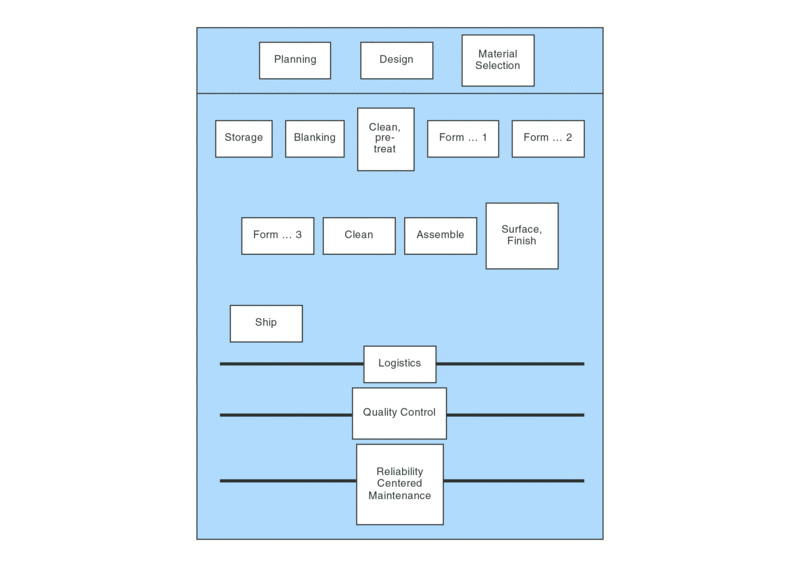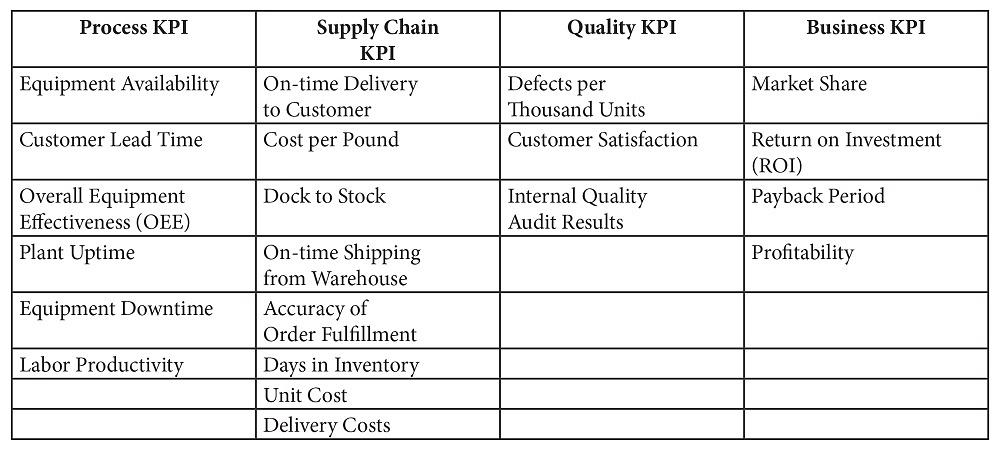President
- FMA
- The Fabricator
- FABTECH
- Canadian Metalworking
Categories
- Additive Manufacturing
- Aluminum Welding
- Arc Welding
- Assembly and Joining
- Automation and Robotics
- Bending and Forming
- Consumables
- Cutting and Weld Prep
- Electric Vehicles
- En Español
- Finishing
- Hydroforming
- Laser Cutting
- Laser Welding
- Machining
- Manufacturing Software
- Materials Handling
- Metals/Materials
- Oxyfuel Cutting
- Plasma Cutting
- Power Tools
- Punching and Other Holemaking
- Roll Forming
- Safety
- Sawing
- Shearing
- Shop Management
- Testing and Measuring
- Tube and Pipe Fabrication
- Tube and Pipe Production
- Waterjet Cutting
Industry Directory
Webcasts
Podcasts
FAB 40
Advertise
Subscribe
Account Login
Search
Using key performance indicators to measure progress
- By Bill Frahm
- January 4, 2017
- Article
- Bending and Forming

Figure 1. Each step in this metal forming process should have performance expectations clearly defined. Key performance indicators then can be used to determine just how close the end results came to expectations.
[Editor’s Note: This is the first installment in a series on designing and using certain key performance indicators to help ensure your success in sheet metal forming.]
Historically, our ability to meet expectations, build quality outcomes, and develop efficient processes demands that we measure our expectations and results. In industry, we call these measures key performance indicators (KPI). In a process as complex as sheet metal forming, identifying and responding to KPIs is important in maintaining a profitable and efficient business.
Did you know that the idiom “measure twice, cut once” has roots in 16th century stamping? Benvenuto Cellini (1500-1571) mentions in his autobiography about a time when he stamped medals of gold, silver, and copper for the pope.
“The ancients never had such medals made for them as these,” the pope said during inspection of the medal and dies.
“It must, most blessed Father, be allowed that in those cases where men are risking all upon one throw, it is not wrong to do as certain poor and simple men are wont to say, who tell us we must mark seven times and cut once,” Cellini responded.
Your company and customers generally demand product quality, timely delivery, competitiveness, and profitability. Sheet metal forming is a complex activity requiring much energy and knowledge. Sheet metal formers produce a large range of products with many differences in dimension, geometry, and batch size. They rely on many different forming technologies, machines, and tooling. They also have a choice from thousands of grades of steel, numerous aluminum series, and other materials that they may be called upon to form. To be competitive, suppliers need robust and agile processes, along with the optimal mix of technologies, machines, and tooling to meet their expected demands.
Meeting these needs requires metal formers to optimize their entire process chains. The key influencers on productivity and quality include tooling, machinery, material properties, tribology, employee knowledge, and the processes themselves. Within the identified parameters of each influencer are interdependencies that affect the process targets and product quality. If you think of a deep-draw operation, the influencing factors in the draw ratio are:
- Material properties
- Sheet thickness
- Tool radii
- Clamping pressure
- Lubricants
- Tooling surface
- Blank surface
- Forming temperature
We measure the formability of the material in terms of its yield strength, elongation, and tensile strength. Machine properties like forming speed, tool hardness, and repeatability also influence our ability to create quality parts. Engineers design the component's geometry, select the appropriate material, and specify production technologies. The challenge is to identify an effective and economical way to produce the workpiece with the company's available equipment and expertise. Good part quality is expected as a minimum requirement. Other criteria to meet include economy, profitability, and delivery performance.
Meeting business expectations requires awareness and vigilance about processes. We use KPI to evaluate our process results and adjust or fine-tune our processes for better performance. Consider Figure 1, which shows a generalized process model for a sheet metal forming application.
Each activity should have performance expectations, along with the appropriate information from each transaction or event. If your performance expectations are properly defined, data should support the use of KPIs to determine how close your actual performance is to your expectations. Effective KPIs should meet the following requirements:
- Descriptive from a technical and organizational perspective
- Supports benchmarking
- Defines interdependencies and cause/effect relationships
- Adapts to organizational needs
- Is collected with relative ease
- Provides comparative analysis to past results

Figure 2. While no specific key performance indicators (KPIs) really exist for the metal forming industry, these KPIs from a general manufacturing process might provide some guidance for a metal former looking to formalize their own usage of this type of tool.
Unlike financial KPIs that are quite common and readily available, a commonly available set of production KPIs for the sheet metal forming industry is not available. Some available KPIs for manufacturing can provide some guidance for metal formers looking to develop their own.
Some examples of useful KPIs can be found in Figure 2.
A Real-world Example of KPI Usage
To demonstrate how a commonly used KPI supports better decision-making, let’s discuss overall equipment effectiveness (OEE), a popular measure of plant and equipment performance.
OEE is the product of availability, performance, and quality.
Availability measures the performance of actual equipment run-time against planned run time.
Availability = Actual Run-Time / Planned Run-Time
Availability is often used to measure the performance of your maintenance program.
Performance measures your efficiency at producing product during run-time. It is a measure of your actual cycle time against planned maximum cycle time.
Performance = (Ideal Cycle Time x Total Count) / Run-Time
Quality measures your performance in producing quality parts. It is a ratio of good parts to those that did not meet quality standards or required rework.
Quality = Good Parts / Total Production
The OEE provides a measure of how well your manufacturing process is running. Mostly it is valuable in tracking overall progress in production and maintenance activities.
As a stand-alone value, OEE offers no insight into the causes of production ineffectiveness. The OEE components—availability, performance, and quality—offer the initial direction in identifying production, maintenance, and process shortcomings.
Sheet metal forming is a complex and violent activity that requires knowledge of metallurgy, tool- and die-making, virtual simulation, forming techniques, and modes of deformation to successfully build product. Likewise, forming and simulation technologies are evolving and require greater skill to operate and maintain. The processes used to select materials, coordinate stock acquisition, move stock through production, monitor equipment operation, and satisfy customer requirements must be monitored continuously to ensure that your production supports your customer and business needs for affordable products of reliable quality.
KPIs are your early warning system to identify process failures. Playing such an important role in the effectiveness of your operations, they need to be defined and identified carefully to help you maintain your ability to meet your company's business and customer requirements.
About the Author

Bill Frahm
P.O. Box 71191
Rochester Hills, MI 48307
248-506-5873
subscribe now

The Fabricator is North America's leading magazine for the metal forming and fabricating industry. The magazine delivers the news, technical articles, and case histories that enable fabricators to do their jobs more efficiently. The Fabricator has served the industry since 1970.
start your free subscription- Stay connected from anywhere

Easily access valuable industry resources now with full access to the digital edition of The Fabricator.

Easily access valuable industry resources now with full access to the digital edition of The Welder.

Easily access valuable industry resources now with full access to the digital edition of The Tube and Pipe Journal.
- Podcasting
- Podcast:
- The Fabricator Podcast
- Published:
- 04/16/2024
- Running Time:
- 63:29
In this episode of The Fabricator Podcast, Caleb Chamberlain, co-founder and CEO of OSH Cut, discusses his company’s...
- Industry Events
16th Annual Safety Conference
- April 30 - May 1, 2024
- Elgin,
Pipe and Tube Conference
- May 21 - 22, 2024
- Omaha, NE
World-Class Roll Forming Workshop
- June 5 - 6, 2024
- Louisville, KY
Advanced Laser Application Workshop
- June 25 - 27, 2024
- Novi, MI































